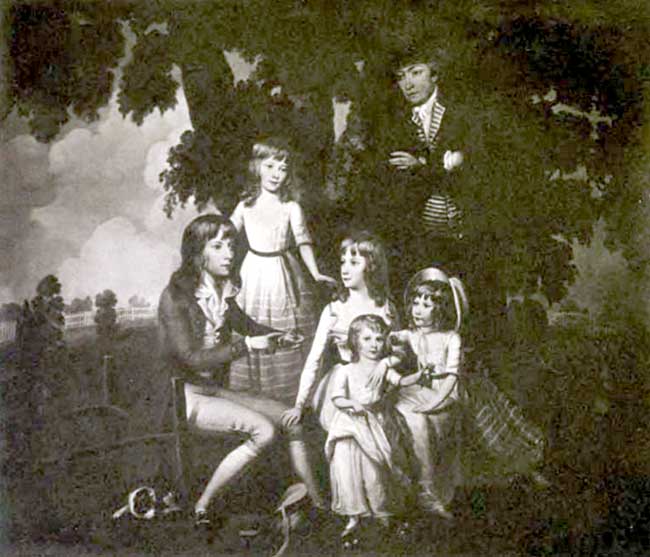The major's next brother was Edmund Cartwright, born in 1743. Something in the Treasury had been found for the eldest son during his father's lifetime. Two of the squire's sons had been given to the navy and one to the army; the career, therefore, of Edmund Cartwright was clear before him. It is superfluous to add that it led to a rectory. But the soldier had taken to radical politics, the surviving sailor to fur-trapping, the Treasury clerk to the Bad, and it was written that Edmund Cartwright should not find his way to the Biographical Dictionary by his divinity. To the mind of the young Edmund it was literature which should lead him towards posthumous fame, and his Amine and Elvira, a Legendary Poem, was long admired in his family, and was well received by that eighteenth century so easily pleased, so artless in its literary pleasures. The twentieth century writer, in the moments when 'the ink and the anguish start,' may look back with an unfeigned regret to the day in which a Hermit, a Pilgrim, and their encounter by a Mossy Cell would furnish all that the public at its Chippendale reading-desk would look for in a polite author. A hermit was not lacking in Armine and Elvira. Rage, Despair, Pity, Distraction, Friendship and Grief, and other abstractions with capital letters, were pleasantly met in the underwoods of the quatrains, and the whole poem, as an admiring daughter most justly observes, is of the 'refined and classic school.'
The rectory was not too long delayed, the living of Goadby Marwood coming to Mr. Edmund in 1779, a rectory with a glebe upon which the rector fell at once to work with experiments in agriculture. The author of Armine and Elvira could never degenerate to the life of Parson Trulliber, but he became a keen and successful farmer, who brought his active Cartwright brains to the toil with an originality which is politely lacking in his gentle verses. A farmer he might have stayed, if aught might be safely predicted of one of these restless brothers, had it not been for a holiday visit to Matlock in Derbyshire. From Matlock he went with a party, Manchester spinners amongst them, to see Arkwright's cotton mills at Cromford. The talk amongst the Manchester men was of the weaving trade going abroad to German cheap labour, and the poet, eager as a Pepys after a new fact, flashed out with the fancy that machines must come to the help of England, and maintained the possibility of such machinery to the contempt of practical Manchester, with a tale of the wonderful movements of the Automatic Chess Player which had been shown in London.

Dr Edmund Cartwright and his family.
Home again at the rectory, he walked his study hour by hour before his delighted children imitating with his hand the cast of the shuttle. Before he had even seen a handloom this wonderful man had framed a clumsy power loom, and his earlier patents were taken out in 1785, 1786, and 1787. The poet, the rector, and the farmer turned weaver, and set up a factory in Doncaster with the first power looms by which wide cloth was ever woven for practical purposes. His wool-combing machine of 1789, in its crudest form, did the work of twenty men, with the result that fifty thousand woolcombers cried aloud to Parliament for the restraint of the rector of Goadby Marwood. 'My father,' says his daughter in her diary, about this time was so absorbed by his machinery that he instituted processions in honour of Bishop Blaise, the patron of woofcombing, which we young people disliked as being a popish ceremony unbecoming his clerical profession.' By 1793 he had come by the fate of the inventor who invents for the generations after him. Thirty thousand pounds of the Cartwright money was sunk in machinery and patents which yielded no return. Giving up the works to his creditors, and his patents to his brothers, he left invention and imagination and fell back upon his poetry, consoling himself with a sonnet on his ill fortune. He came to try his fortune in London, where, the itch of invention taking him anew, he built a house with his own patent geometrical bricks, patented an alcohol engine, and experimented with the application of steam to navigation. In intervals of leisure he invented a reaping machine, wrote a prize essay on husbandry, and became manager of the Duke of Bedford's experimental farm at Woburn.
Now and again he was reminded of his orders. Lincoln made the maker of the power loom a prebendary, and Oxford in 1806 gave the degree of Doctor of Divinity to the patentee of the geometrical brick. He lived to see the power loom making wealth for others, and to define a patent as 'a feeble protection against the rapacity, piracy and theft of too many of the manufacturing class.' Parliament in 1809 gave £10,000 to the man who had shown the way to the northern millionaires, and the Rev. Dr. Edmund Cartwright took the sum like a philosopher and bought a farm in Kent with it. His active and, one must believe, his happy life was lived out busily to the end. Little there was in nature that he did not finger. In his parish he practised medicine, and 'exhibited ' yeast in a case of putrid fever with a recorded success. In his eighty-third year he offered the Royal Society a theory of the movement of planets round the sun. The year before his death, in 1823, he was at Dover for warm bathing in sea-water, and though old and ill he must needs teach his bathing man a method of filling his cistern by an application of power.
He was the only one of the brothers to carry on the family.1 The next generation was a less strenuous one, but it produced the Reverend Edmund Cartwright, F.S.A., a topographer and county historian who in 1830, with the aid of his friend the Duke of Norfolk, made a respectable continuation to Dallaway's History of Sussex. He married twice, his first wife being one who, had she borne children, would have brought a curious strain of blood to the family. She was the daughter of John Wombwell, apparently a cousin german of the first baronet of that name, by a lady who is styled in the family records a Persian princess. The child of this union was married to Mr. Cartwright in 1795 at St. George's, Hanover Square, and died in February of the next year, being then but a child of sixteen years.
Of the daughters of the inventor one lived with her uncle, the reforming major, and wrote his life. Another wrote a memoir of her father. A third daughter was Elizabeth, who married in 1814 the Reverend John Penrose, a Bampton lecturer, and dying in 1837 was buried in Lincoln Cathedral. Few will recognize from this description one of the most famous of our countrywomen, one whose work three generations of English children have thumbed. For Elizabeth Cartwright, Mrs. John Penrose, was no other than the Mrs. Markham of our childhood, Mrs. Markham of the history book.
Let us laugh indulgently as we remember the conversation of Richard and George, of their sister and their mamma. Before the day of Mrs. Markham the history of our country was administered to the young from the ponderous inaccuracies of Rapin, the dulness of Goldsmith's unwelcome task. From Mrs. Markham in her later form, made glorious with charging knights and battling archers 'from an old MS.,' many a child has persuaded himself to grow up a man to whom the history of the English and the mystery of old and far-off days are not things which may be lightly cast into that calm limbo where rest for the most of us the irregularities of the Greek verb.
There are school room histories nowadays which even in the matter of the pictures in the margin drive poor Mrs. Markham from her pride of place, and much of her chronicle was the Berlin woolwork of history, now sadly faded. But from 1823 to 1880, at the least, all young England learned history at Mrs. Markham's knee. Little Arthur was her wash-pot, over Mrs. Mangnall she cast forth her shoe, and, be it said to her credit, her steady popularity saved a generation of us from the rant of that Child's History of England, in which a great man went so deplorably beyond his last.
The year 1904 has seen an attempt to give his due measure of fame to one of this family of Cartwright. Bradford and Lord Masham have raised the Cartwright memorial hall in honour of the name of Edmund Cartwright, upon whose labours the town's prosperity rests. Lord Masham, in reproaching his countrymen with having so easily forgotten Edmund Cartwright, did not hesitate to call him the greatest of English inventors, beside whose achievements those of Stephenson and Watt suffer in comparison. This article will have served its purpose in showing that so famous a man was English in blood and nurture.
O. B.
1. Our family picture of Cartwright and his children is thus described in his daughter's notes for 1786—'In this year my brother and sisters and myself all met together at Doncaster and had our picture taken by Mr. Hawes. We are represented sitting under the great mulberry tree at Mirfield Hall, my father standing behind and looking at us with a pensive expression of countenance well suited to his widowed situation.'
